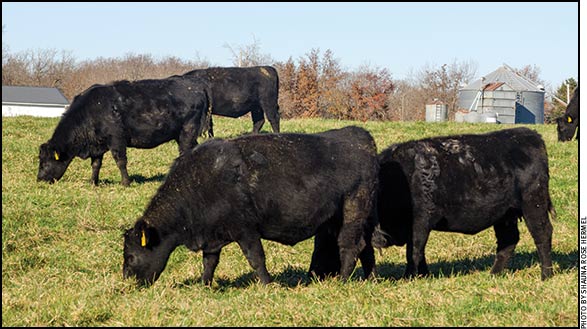
Target Weight Considerations
Whether you choose 55% or 65% of mature weight as a breeding-weight target should depend on cows, resources and management.
Both preweaning and postweaning nutrition are important to the development of replacement heifers, but most beef herd managers have more opportunity to manipulate nutrition after weaning. To help managers avoid having nutrition be a limiting factor in replacement heifers’ ability to become pregnant, the target weight concept was proposed. This gave managers a goal of having heifers reach a certain percentage of their mature weight by the beginning of the first breeding season.

“It’s a forgiving system, but associated feed costs can be high,” said John Hall, University of Idaho animal scientist, referring to the 65% target. “It reduces selection for early fertility and sometimes heifers can become overconditioned.”
During the 2016 Applied Reproductive Strategies in Beef Cattle (ARSBC) Symposium, University of Idaho animal scientist John Hall talked about the target weight concept and the debate over which of two different targets may be most appropriate. Hall suggested that the answer may not be the same for every cow-calf producer.
For many years, the rule of thumb called for heifers to be developed to 65% of mature weight — a recommendation Hall said was based on sound science. Both research and practical experience suggested this target weight was effective over a large number of environments and breed types, and especially for large-framed heifers. The 65% target ensured a large percentage of heifers would become pubertal by the beginning of the breeding season.
“It’s a forgiving system, but associated feed costs can be high. It reduces selection for early fertility and sometimes heifers can become overconditioned,” said Hall, also noting the potential for “pasture crash,” when heifers accustomed to a fed ration containing some grain are abruptly turned out to pasture and a strictly grazed forage diet.
Hall explained that more recent research has suggested that heifers could be developed to 55% of mature weight at less cost, and still exhibit acceptable reproductive performance. With the lower target weight as a goal, heifers could be grown on feedstuffs similar to those they would consume as mature cows. This system affords selection for adaptability to the given environment and potentially subfertile heifers can be eliminated for failure to breed. Some data suggest that heifers developed on more restricted diets may exhibit lower pregnancy rates to artificial insemination (AI), while other studies showed rates comparable to heifers developed to heavier target weights.
Hall suggested that the 65% target weight may best fit operations with good forage resources, involving purebred herds or small commercial herds consisting of later-maturing, large-framed cattle. The 55% target weight goal may be a better fit for developing early-maturing heifers from herds consisting of small and moderately framed cattle maintained in environments with more restricted feed resources. This target also favors operations having the ability to market open yearling heifers.

Editor’s Note: The 2016 ARSBC was hosted in Des Moines, Iowa, Sept. 7-8. Hall spoke during a session featuring nutritional effects on reproduction. Visit the Newsroom at www.appliedreprostrategies.com to view his PowerPoint, read the proceedings or listen to the presentation. Compiled by the Angus Media editorial team, the site is made possible through sponsorship by the Beef Reproduction Task Force






